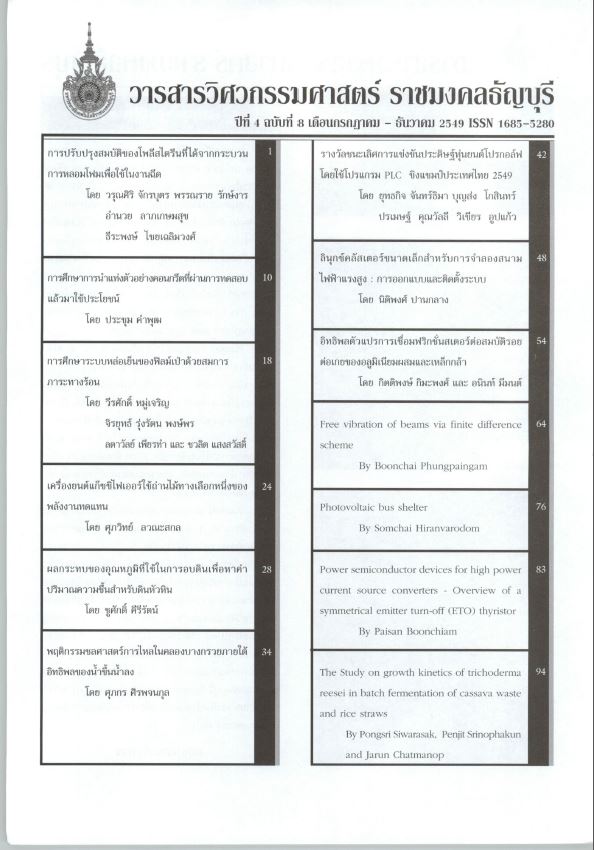A Study of Utilizing of Recycled Concrete Specimens
Main Article Content
Abstract
This research is to study the utilizing of recycled concrete specimens in both forms of cylindrical and cubic. There are 2 means of advantage: direct mean (the concrete does not pass the process of crushing) such as covering the soil surface for protect the soil surface. planted the trees. organize the garden and use for roadside in the traffic. indirect mean (the concrete pass the process of crushing), the concrete is reused as coarse aggregate instead of rock in concrete for the parts of building which do not require high compressive strength of concrete. The sieve analysis according with ASTM C 136 is performed to have the same size standard as coarse aggregate in concrete. After testing. the properties of the recycled concrete were found; the average absorption = 4.59%. the specific gravity = 1.97, design the mixed ratio cement: sand: recycled concrete = I : 2: 4 by weight. Then making an examination by casting a cube sizing of 15 x 15 x 15 cu.crn. followed the BS 1881 standard and using water cement ratio = 0.45. 0.50 and 0.55 . The result showed the average bulk unit weight is 2222 . 2242 and 2261 kg/cu.m respectively and the average compressive strength at 28 days = 357. 346 and 33 1 ksc. The compressive strength of normal concrete (mixed with rock) = 389. 380 and 372 ksc respectively. This research showed that recycled concrete could be well utilized in both means (direct and indirect means ).
Article Details
The manuscript, information, content, picture and so forth which were published on Frontiers in engineering innovation research has been a copyright of this journal only. There is not allow anyone or any organize to duplicate all content or some document for unethical publication.
References
เมธี บุญเลี้ยงอุปถัมภ์และฉัตรชัย ชูพานิช, 2543 คู่มือการทดสอบ หิน ทราย และคอนกรีต. พิมพ์ครั้งที่ 3. กรุงเทพมหานคร: บริษัทผลิตกัณฑ์และวัตถุก่อสร้าง จำกัด.
ธัชวีร์ ลีละวัฒน์, 2546. การนำเอาวัสดุเหลือใช้จากการก่อสร้างและทุบทำลายมาใช้ให้แทนที่มวลรวมจากธรรมชาติในประเทศเคนมาร์ก. วารสารโยธาสาร.
มงคล จิรวัชรเดช, 2543. คุณสมบัติเชิงกลของคอนกรีตมวลรวมเบาจากเศษอิฐหัก. การประชุมวิชาการวิศวกรรมโยธาแห่งชาติ ครั้งที่ 6, โรงแรมดุสิต รีสอร์ท แอนค์ โปโลกลับ ชะอำ เพชรบุรี.0-12 พฤษภาคม, หนำ MAT-119-MAT-124
American Society for Testing and Materials,2001. ASTM C136-96a: Standard Test Method for Sieve Analysis of Fine and Coarse Aggregates,Annual Book of ASTM Standards. Vol04.02, Philadelphia, 78-82.
American Society for Testing and Materials,2001. ASTM C127-88 [Reapproved 2001]: Standard Test Method for Specific Gravity and Absorption of Coarse Aggregates, Annual Book of ASTM Standards. Vol. 04.02, Philadelphia,64-68.
American Society for Testing and Materials,2001. ASTM C128-97: Standard Test Method for Specific Gravity and Absorption of Fine Aggregates, Annual Book of ASTM Standards.Vol. 04.02, Philadelphia, 69-73.
British Standard Institute, 1983. BS 1881: PART 3 Method of Making and Curing Test Specimens, London.
British Standard Institute, 1983. BS 1881: PART 4 Method of 'Testing Concrete for Strength,
London.
ชัชวาลย์ เศรษฐบุตร 2542. คอนกรีตทคโนโลยี.พิมพัดรั้งที่ 7 ,กรุงเทพมหานคร บริษัท ผลิตภัณฑ์และวัตถุกอสร้าง จำกัด.


